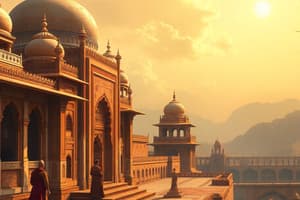Podcast
Questions and Answers
Who were the Mughal emperors patrons of during their reign?
Who were the Mughal emperors patrons of during their reign?
- Artists, scholars, poets, musicians, painters, and architects (correct)
- Engineers and architects
- Warriors and generals
- Scientists and philosophers
Which famous monument was built under the Mughal emperors' patronage?
Which famous monument was built under the Mughal emperors' patronage?
- Eiffel Tower
- Red Fort (correct)
- Statue of Liberty
- Big Ben
Which sector thrived under Mughal rule due to efficient collection and transportation systems?
Which sector thrived under Mughal rule due to efficient collection and transportation systems?
- Textiles (correct)
- Mining
- Technology
- Agriculture
What contributed to the decline of the Mughal power in the late 17th and early 18th centuries?
What contributed to the decline of the Mughal power in the late 17th and early 18th centuries?
What neighboring kingdoms invaded Mughal territories, contributing to their decline?
What neighboring kingdoms invaded Mughal territories, contributing to their decline?
Who succeeded Babur as the Mughal Emperor?
Who succeeded Babur as the Mughal Emperor?
Which Mughal Emperor is known for promoting religious tolerance and creating a multi-ethnic society?
Which Mughal Emperor is known for promoting religious tolerance and creating a multi-ethnic society?
During which Mughal Emperor's reign was the Taj Mahal built?
During which Mughal Emperor's reign was the Taj Mahal built?
What key aspects led to the decline of the Mughal Empire?
What key aspects led to the decline of the Mughal Empire?
Which Mughal Emperor is associated with the empire's expansion to encompass most of South Asia?
Which Mughal Emperor is associated with the empire's expansion to encompass most of South Asia?
Flashcards are hidden until you start studying
Study Notes
Mughal Empire
The Mughal Empire was a vast realm spanning most of India from 1526 until its decline in the mid-to-late 18th century. It originated with Babur, who overran northern India by force and founded the empire after defeating the Lodis in battle. Over time, the Mughals expanded their territory through military conquests and diplomatic marriages, eventually ruling over much of South Asia. Here's a brief overview of some key aspects of this historic dynasty:
Emperors
Babur ruled briefly before being succeeded by his son Humayun, who lost control of his territories when he was deposed and later restored them upon returning from Persia. His grandson Akbar became one of the greatest rulers, advancing the state into a mature form and expanding its boundaries to encompass most of the Indian subcontinent. Akbar is remembered for promoting religious tolerance and for creating what we would now call a multi-ethnic, multilingual, and multi-religious society. He created a new administrative system based on two primary functions: revenue collection and justice dispensation.
Akbar was followed by several strong emperors, including Jahangir, Shah Jahan, and Aurangzeb. Each left their mark on the empire, with Shah Jahan perhaps best known for building Taj Mahal during Aurangzeb's reign saw the beginning of a period of economic stagnancy and political instability.
Culture
During the height of their power, the Mughal emperors were patrons of art, literature, music, architecture, and other cultural pursuits. They established a tradition of inviting artists, scholars, poets, musicians, painters, and architects to exalted positions within the royal court. Many famous monuments such as the Red Fort, Agra Fort, Fatehpur Sikri, and the Taj Mahal were built under patronage of these great leaders.
Several poets and writers rose to prominence during this era, including Abul Fazl, Amir Khusro, Guru Nanak Dev Ji, and Bhagat Kabir. These individuals contributed significantly to the development of literary traditions in various languages used throughout the empire.
Economy
The economy thrived under Mughal rule due to their efficient collection and transportation systems, which helped spread goods across the country. Trade routes led to the growth of commerce, especially textiles, with exports reaching far corners of the world. Agriculture also flourished under the supervision of the Mughal governance, resulting in increased food production.
Decline
In the late 17th and early 18th centuries, a combination of factors began to erode Mughal power. Economic mismanagement, political infighting among successive rulers, and an increasing reliance on European mercenaries weakened the central government. Additionally, invasions from neighboring kingdoms like Marathas, Afghans, Bhumihars, Jats, Sikhs, and Rohillas further diminished the influence of Mughal authority. By the second half of the 18th century, the once powerful empire had disintegrated into numerous petty states warring against each other.
Today, the legacy of the Mughal Empire lives on in the rich heritage it has left behind. Its strategic importance lies not only in its historical significance but also in how it shaped modern India by introducing progressive policies such as land reforms, administrative divisions, and fiscal management practices.
Studying That Suits You
Use AI to generate personalized quizzes and flashcards to suit your learning preferences.




